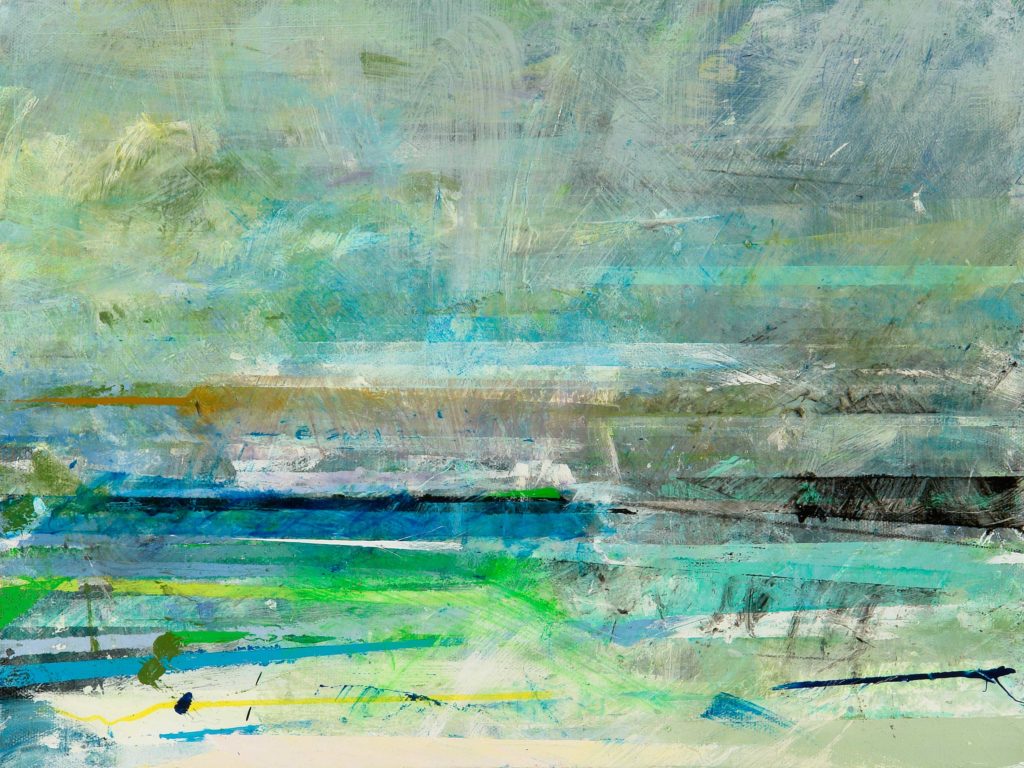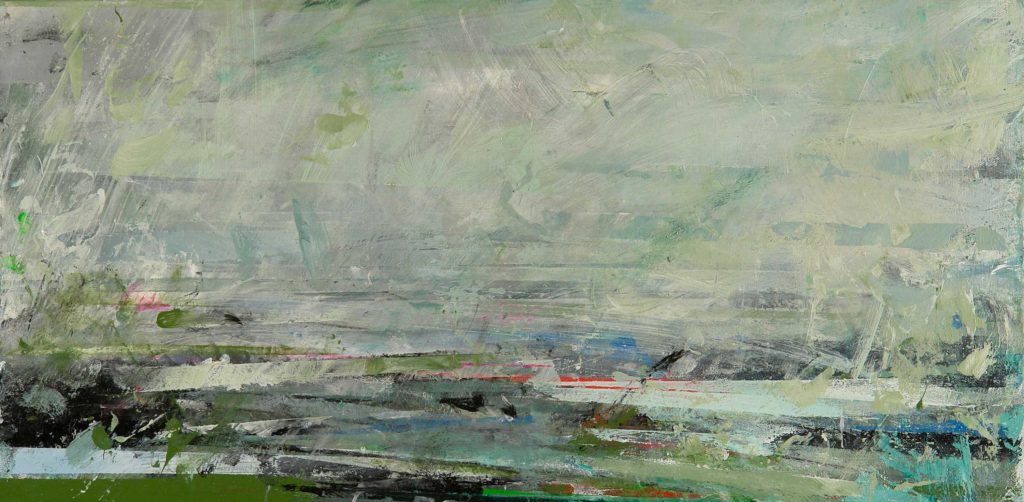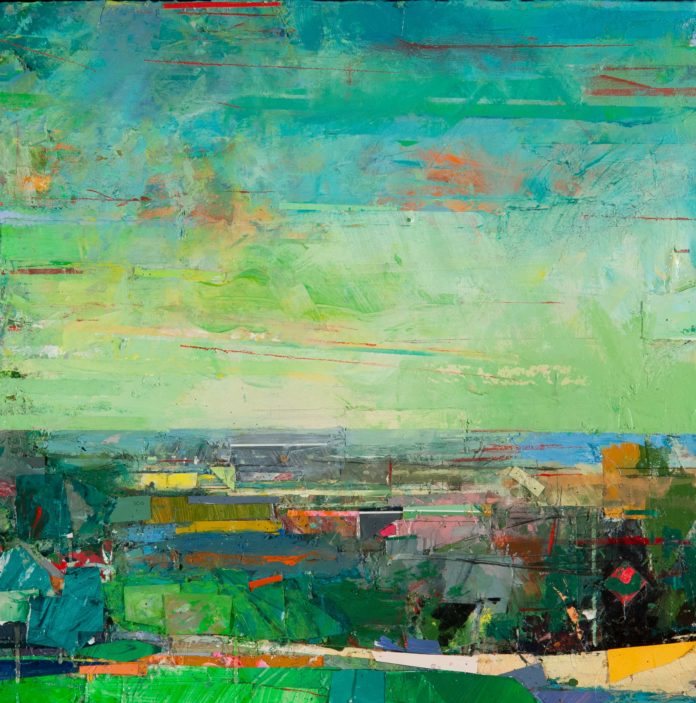Coming out of our teachers, the places we loved, and how we find ourselves now.
By Andrew Wykes
The English landscape painter John Constable once wrote, “I should paint my own places best.” Indeed that is the whole pretext of my early work. I was born in Surrey, England and grew up with the country of the gentle rolling North Downs on one hand, and on the other the engaging, changeable urban buildup of suburbs developing to the City of London.

For me, painting is synonymous with seeing. I have always got great pleasure through the eyes. Many years ago, commuting to Art College in London, I would relish the train journey, preferring to look out the grimy railway carriage window instead of reading or sleeping. It was with great delight I was viewing the Green Belt unfolding to unpretentious urban and then to city landscape. I was seeing the familiar become unfamiliar through the shift of light, juxtaposition of spaces, colours and forms.
Much of my work before I relocated to Minnesota was coming out of a passionate if not adoring attachment to my surroundings. I thought that position would not change, but it did. For the first ten years in my new home I was at a loss, homesick and depressed. Do we not often find the loss of something or a person that was important to us as having a strange but not contradictory relationship?

The opposite of loss is possession. If something is important to us, we begin to possess it internally—perhaps more strongly than when we possessed it externally. One’s memories become more significant, valid, richer and almost palpable in their tender absence. This is not nostalgia, it is not the looking into the past, but perhaps in a curious way looking into or directed towards the future. This is not unique to me; I am stealing, as all artists and writers do.
One might say I came from a privileged background, growing up in the 1960s through to the early 90s in West London. I now feel fortunate in the sense that I could be part of a rich assortment of treasure and deep history to tap into. I had easy access to the major free collections of the London galleries, the Tate Gallery and The National Gallery with its prominent international exhibits of the day. All this happened in the milieu of a society that houses so many of the major past and contemporary inspiring artists and art movements. Of course this all seemed natural to me and only on moving later in life to the Midwest of the United States did I realize these opportunities that shaped me as an artist.

At the age of fifteen, I was struck by the Constable paintings in the National Gallery collection in London—shadowy, dramatic with an inherent poetic quality. I felt more was going on than mere depiction. The drive behind them was on one level a personal experience of place, and yet the work holds a pantheistic view of the world. I treasured the dusky tonal colors of horizons and trees; subdued chrome greens and gray pallid Prussian blues.
These also had a direct and recognizable characteristic that I saw and enjoyed in the landscape. In reproductions of Constable this does not come through. Also what impressed me, and still does, is Constable’s determination to get it right. While employing a controlled, well-ordered direct means of working, his goal was to make a parallel of what he sees in real time and space, on a flat surface and to give it immutability.
The painter Stanley Lewis, my old friend and former teacher at American University, would impress upon me that “we are all coming out of our teachers.” Lewis draws and paints on-site what he sees—his own backyard and local streets of Leeds, Massachusetts.
His paintings are about seeing—seeing objectively and with detachment. The proposition is a constant that all painting is abstract. As I am, Lewis is coming out of the sensibilities of eighteenth- and nineteenth-century European painting, from Ruisdael to Constable to Cézanne—a direct linkage. But with Lewis there are other influences, such as Jean Hélion and Leland Bell, his teacher at Yale.
The question in Stanley’s mind is, “How can paint address the quality of light and presence of a place so as to rival the experience of the place itself?” This is a question of timelessness that continues to haunt me.
Another distinctive voice that I have been engrossed with is the British painter Patrick George (1923-2016). For his painting “Hickbush” (1961-1965), I discovered it was painted on the spot over a period of five years. I was curious about the length of time and seamlessly minor changes on the painting that I had known from a well-loved postcard on my studio wall as a student. Some thirty years later, I saw the original in the Tate Gallery. The size and reworking of the surface was so refreshing, almost a shock; seeing it made sense that the intent of the painting was to fix on something tangible and not ephemeral. George chose measure over the unstable effects through uncertain changeable seasons. The end result was a synthesis of time and change in preference for something more constant, more real and not yearning.
What I’m getting at is that in our own being we carry a natural allegory to landscape that is timeless and constant. As a professor of Painting in a liberal arts American college, I have been stimulated to think in cross-curricular ways. A geologist in England, Professor Jay Appleton, has been writing about landscape and natural symbolism.
In Appleton’s theory of a natural symbolism of habitat, he suggests that there is a basic symbolism present in our landscape environment (including garden landscape, buildings, street scenes, countryside, etc.) that survives from man’s earliest beginning. Perceptions of this symbolism in visual representations are hypothesized by him to elicit specific feelings descendent from our drive for survival: prospect, which signals opportunity to see or explore; refuge, which implies protection; and hazard, which stirs feelings of wanting to escape.

It is interesting to note that in a great deal of landscape painting, the concepts of prospect and refuge are jointly present; in fact, these notions find their way into most visual renderings. In Ruisdael’s painting of Haarlem, the artist’s viewpoint is from a high vantage point of prospect above small, domestic, warmly lit dwellings symbolizing refuge, and then out to the prospect of the straight, low horizon extending under a vast sky of billowing cumulus clouds.
I have often seen this as a universal animal response. And it is possibly what we carry around in our subconscious—at times a deep, timeless universal connection.
I have always been conscious of and muse about what it is that I bring to the landscape before me, on any particular moment, or what it gives to me. My cultural and geographical influences certainly play their part in how I view my surroundings, but there is also my personal visual history and emotional recollection from the past.
These are hazy memoirs, often lodged deep in my unconscious, and at best, I have only vague ideas about their sources. But these states of mind are charged with palpable feelings that are set off unexpectedly during the act of looking at and painting the land before me: how brilliant midday sun is absorbed into the night-dark foliage of an aging oak tree; the distant hum of a pale blue horizon seen unexpectedly from around a corner. The experience of painting a landscape “on site” can bring me feelings of refuge or unease as well as melancholy or hope—feelings that hold me in the present moment. I am aware that the landscape itself is unresponsive. The love I feel for it will not change it from its position of indifference.

I always remember what Bridget Riley said, “Other artists teach you. There is one thing I say to my students and that is this: look at great painters; don’t be frightened of them, they have seen more clearly, experienced more genuinely and are more explicit. Weaker artists are confused. Read. The best look at the best. Don’t rely on your contemporaries. Look at the past.”
Learn more about Andrew at: www.andrewwykes.com
> Visit EricRhoads.com to learn about more opportunities for artists and art collectors, including retreats, international art trips, art conventions, and more.
> Sign up to receive Fine Art Today, our free weekly e-newsletter
> Subscribe to Fine Art Connoisseur magazine, so you never miss an issue







